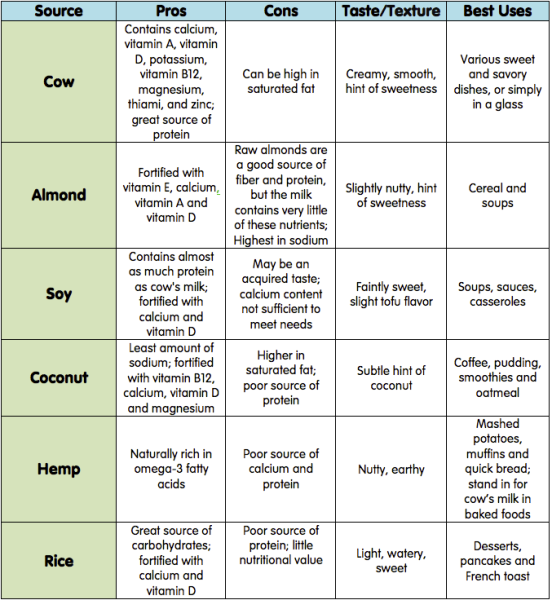
Got Milk? Or Milk Alternatives?
Milk from cows and goats has widely been used for hundreds of years, and was previously the most commonly preferred milk for nourishment. Today, however, individuals have more choices and are consuming less milk and turning to milk alternatives for various reasons, some which include allergies, lactose intolerance or a vegan diet. Bovine or cow’s milk is best known for calcium, which promotes strong bones and growing bodies. It is also fortified with vitamin A and D, with vitamin D aiding in calcium absorption. And calcium is not the only benefit of milk; it provides various other vitamins and minerals in addition to protein, fat and calories.
How do milk alternatives measure up? The most common milk alternatives are compared in the table below.
Milk/Milk Alternative Comparison Chart (per 1 cup)

*Label-reading tip: When looking at nutrition labels, less than 20 percent daily value (DV) is considered to be “high” or “excellent” in that nutrient. 10-19 percent daily value is considered to be “good.”
Reviewing the table above, you may notice that milk alternatives are created to mimic cow’s milk; however, they don’t always measure up. The largest area of concern is protein, which is an important nutrient. Our body relies on protein to build, maintain and replace the tissues in the body. Though milk does not contain more than 20 percent of your daily value, it remains within the “good” category. Also, because it is an animal-based, it contains essential building blocks for our body, making it even more valuable. When consuming milk alternatives you will want to ensure your child’s diet is well varied to include other sources of protein, to ensure appropriate growth of muscles, organs and bones.
Calcium is also an important mineral for your child, as it is the key building block for strong and healthy bones, and plays an important part in making sure that muscles and nerves are working properly. When not enough calcium is consumed, the body will pull calcium from the bones to make up for the deficit. This can be harmful and put young children at increased risk of poor growth and potential bone-softening diseases such as osteoporosis. When choosing milk alternatives, you will want to ensure the percent daily value is greater than 20 percent.

So which milk comes out ahead? Milk alternatives can be a great way to include new options in your child’s diet, especially if your child has a dairy allergy; however, be mindful of important components like protein and calcium. Keep in mind, just because it’s white, doesn’t make it milk. When in doubt, always consult your dietitian or physician to ensure that milk alternatives are the best option for your child.

